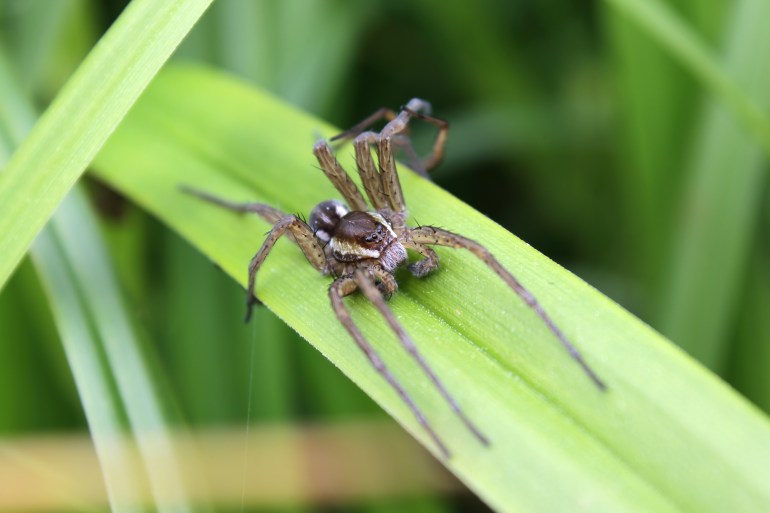This week, several newspapers and tabloids in the United Kingdom published claims that 10,000 mammoth spiders, which some said were as big as rats, had been let loose across the country.
One report in the tabloid the Daily Mail read: “Thousands of giant spiders ‘the size of a human hand’ are on the loose in the UK after a zoo decided to let them run free.”
However, scientists have since clarified that while thousands of spiders were intentionally bred and released years ago, they are not “running free” and are not as big as is being claimed.
Here’s what we know about how this tale was spun and the real story behind it:
What really happened?
In August, the Royal Society for the Protection of Birds (RSPB) and a host of other conservation societies announced that great raft spiders (also known as fen raft spiders), which are classified as “vulnerable” by the International Union for Conservation of Nature (IUCN) and as “Nationally Rare” in the UK, were making a comeback in parts of the country.
Those areas include The Broads, a network of lakes, rivers and Britain’s largest protected wetlands that transverse the northeastern Norfolk and Suffolk counties.
The spider’s population recovery is due to years of intense conservation by scientists. Before these efforts, there were only a “handful” of great raft spiders, UK newspapers claim. The Chester Zoo estimates that across the UK, there might now be as many as 10,000 of the arachnids. According to the RSPB, a recent survey found that the population of female great raft spiders had reached well into the thousands, with an estimated 3,750 in Norfolk alone with the number of their population sites increasing from three to 12.
It’s “an impressive figure for a species that was previously at risk of extinction in just 2010,” the August statement by the RSPB said. The species, the organisation added, remains vulnerable but is no longer at risk of extinction.
The IUCN still lists the spider as vulnerable on its Red List of Threatened Species, a designation given in 1996. Scientists say it is likely that, pre-historically, the spiders were “extremely” abundant across Europe.
Breeding usually occurs in July and September. RSPB experts have forecasted that this past year was the spiders’ “best year on record” for breeding, and was likely to boost the population.

What type of spiders are they?
Great raft spiders (Dolomedes plantarius) are a European species known for their large size and white or cream stripes running along the sides of their black or brown bodies. The spiders, which have a two-year lifespan, are harmless to humans and, because they typically live in wet environments, are unlikely to be found inside residential buildings.
Females are bigger than males. At full length, including the span of spread-out legs, females can measure up to 70 millimetres (2.8 inches). If you place one on the palm of an adult human, which is about 75 millimetres (3 inches) on average, the spider would cover the inner surface.
“This is easily reported as ‘the size of a man’s hand’ or maybe ‘the length of a newborn rat’… (and at a stretch) expanded to ‘rat-sized’,” Dave Clarke, a conservationist at the London Zoo, wrote in a blog in September.
However, the Chester Zoo, in a post on X last week, used the phrase “they grow to be the size of your hands”, to describe the spiders.
Ten years ago we helped release THOUSANDS of GIANT spiders back into the UK! 🕷️🇬🇧
The fen raft spiders were bred right here at the zoo, and we’re super happy to report there’s now more than 10,000 breeding females… and they’ve just had the biggest mating season on record! 👀… pic.twitter.com/xXvpRe24iU
— Chester Zoo (@chesterzoo) October 30, 2024
Great raft spiders actively hunt, rather than build webs to catch food. They are semi-aquatic, able to flit across the surface of water bodies to catch their prey. Tiny leg hairs help them to detect vibrations on the water’s surface. Males also use that hair-based sensory system to communicate with females during courtship, testing their reception by tapping the water’s surface. Great raft spiders eat the larvae of dragonflies, damselflies, tadpoles and small fish, as well as other spiders.
Females are fiercely protective of their eggs. When breeding, the mother builds an egg sac to carry her hundreds of babies — typically for around three weeks — while she also forages for food. Just before the babies hatch, the mama spider spins a silky “nursery” web about the size of a pizza, suspended above water, to keep the newborns and herself safe.
In Britain, fen raft spiders live on unpolluted or alkaline canals and fens or grazing marshes of boggy peatland rich with reeds and rushes.
Conservationists say humans are highly unlikely to encounter a fen raft spider, as they only inhabit a handful of protected wetlands in the UK. In other parts of Europe, like Scandinavia, the spiders are found on the edges of natural lakes.
What happened to the spiders?
Great raft spiders nearly went extinct in the UK due to the destruction of their natural habitat. Scientists found that in East Anglia, for example, a reduced year-round supply of water to some marshes — a lot of runoff water was being increasingly diverted to public water sources — helped lead to the spiders’ decline.
Intensifying summer droughts in the UK — a result of climate change — compounded the issue significantly, scientists say.
Parts of continental Europe have also seen declines in great raft spider populations. In the Netherlands, evidence suggests that marshes and water bodies with accumulated agricultural or fertiliser runoff have also seen lower numbers. However, populations are well-established in the Baltics and Scandinavia.
How were they conserved?
Between 2011 and 2013, in efforts led by RSPB, scientists at UK zoos and conservation institutions collaborated to breed hundreds of spider babies in individual test tubes (so they would not eat each other).
“Our team delicately hand-fed tiny flies to each of the hundreds of spiderlings using tweezers, day in, day out, for weeks on end in our bio-secure breeding facility,” said a statement by the Chester Zoo, which was part of the conservation project. “Eventually, the young spiders grew strong enough to be returned to their natural habitat, which our partners worked to restore, and we released them in their hundreds.”
Clarke from the London Zoo, which also participated in the project, wrote in a blog post that the spider babies were introduced to “new and suitable environments”, which included protected wetlands. This is contrary to claims of the spiders being let loose all over the country.
Clarke wrote that there’s no reason to be fearful of the increased spider numbers as they are not likely to spread to residential areas, noting “This is a huge conservation success, both for the spiders and the wider habitat restoration driving the success… Misinformation like this just fuels people’s arachnophobia [fear of spiders].”











More Stories
US election: It’s voting day – What polls say; what Harris, Trump are up to
Boeing workers vote to end seven-week strike
Evidence will be retested in Boulder murder case after investigation opened into DNA analyst